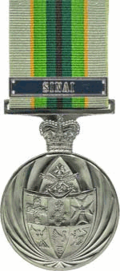| Australian Service Medal | |
|---|---|
  Obverse (left), reverse (right) and ribbon (bottom) of medal with SINAI clasp | |
| Type | Campaign Medal |
| Awarded for | Service in non-warlike operations |
| Presented by | Australia |
| Eligibility | Australian Defence Force personnel |
| Status | No longer awarded, those who qualify can still apply |
| Established | 13 September 1988 |
| Total | 38,681 as at 30 June 2010 |
| Order of Wear | |
| Next (higher) | Australian General Service Medal Korea |
| Next (lower) | Rhodesia Medal |
| Related | Australian Service Medal 1945–1975 |
The Australian Service Medal is an Australian military decoration. It was authorised 13 September 1988 to recognise prescribed service in peacekeeping and non-warlike operations. It is awarded with a clasp to denote the prescribed operation and subsequent awards of the medal are made in the form of additional clasps. The Australian Service Medal 1945–1975 recognises non-warlike service prior to February 1975. The Australian Service Medal was replaced in 2012 by the Australian Operational Service Medal, except for ongoing missions. [1]
Contents
- Description
- Related medals
- Clasps
- Balkans
- Bougainville
- Cambodia
- CT/SR
- East Timor
- Ethiopia/Eritrea
- Guatemala
- Gulf
- Haiti
- Iran/Iraq
- Iraq
- Irian Jaya
- Kashmir
- Korea
- Kuwait
- Lebanon
- Middle East
- Mozambique
- Peshawar
- Sierra Leone
- Sinai
- Solomon Islands
- Solomon Islands II
- SE Asia
- S Pacific 2006
- Special Ops
- Sudan
- South Sudan
- Timor-Leste
- Uganda
- West Sahara
- Superseded clasps
- Fiji 2006
- Namibia
- Rwanda
- Vietnam 1975
- Revoked clasps
- Somalia
- See also
- References
- External links